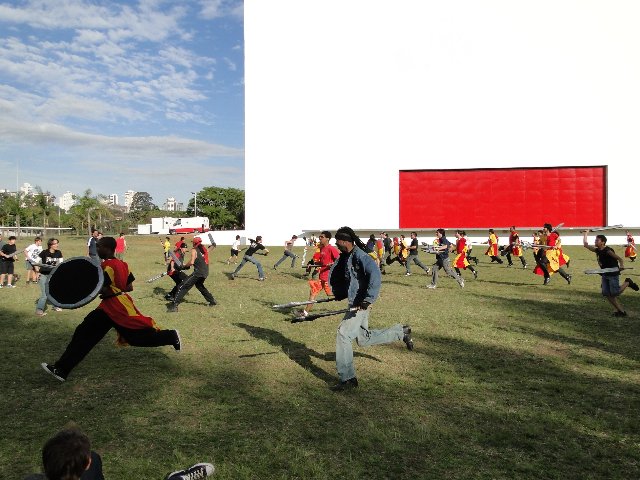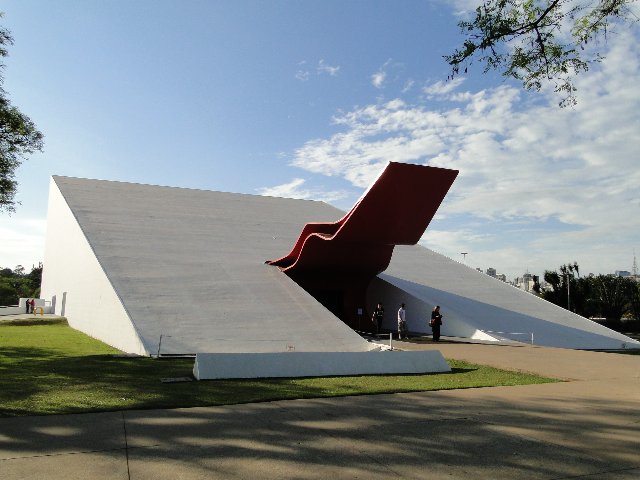Oscar Niemeyer’s Auditório Ibirapuera (inaugurated 2005), in Ibirapuera Park, São Paulo
Modernism and cyber-medievalism
Entrance, Auditório Ibirapuera (the portal has been nicknamed Labareda which is Portuguese for ‘flame’).
Interior
At the age of 103, Niemeyer has plans for a university that will efface distinctions between disciplines – in order, as he says, ‘To eliminate the specialist man’.
I’m wondering when they’ll start taking applications.
For an interesting interview see:
http://www.ft.com/cms/s/2/db740a7a-e897-11db-b2c3-000b5df10621.html#ixzz1YykPmnQn
The common denominator of Niemeyer’s old and new projects is his consistent exploration of reinforced concrete’s versatility, his drive to create structures that seem lighter even as they become larger. ”My ambition has always been to reduce a building’s support to a minimum,” he reflects. ”The more we diminish supporting structures, the more audacious and important the architecture is. That has been my life’s work.” For that work he was awarded the 1988 Pritzker Prize.
Long a member of the communist party, Niemeyer is a vocal defender of left-wing governments in Brazil and abroad. His Bolivar monument, in Caracas, will be shaped like a lance pointing at the US. In an accompanying text to the Paco Imperial exhibition, he writes: ”Only in politics I am intransigent and radical – I am against Bush’s murderous empire, and against anyone who in this country opposes [president] Lula”.
Can politics and architecture mix? ”Architecture doesn’t matter,” Niemeyer tells me. ”Someone who is out on the streets protesting is doing a much more important job than I am. Politics matters. Changing the world matters because we live in a shit world.” What, I ask, can architecture do to change the world? Nothing, he replies.
Yet one of his current projects betrays an entrenched idealism – he has plans for a university designed to eradicate barriers between intellectual disciplines. ”To eliminate the specialist man”, he says solemnly, as if this worthy humanist ideal were not an ancient one.
There is a favourite phrase of Niemeyer’s. I have heard him say it at interviews, and read it in his books. Even as my 15 minutes run out, he is not prepared to let me go without reiterating it for my benefit: ”Life is more important than architecture.”





Sorry for continuing to comment, but I could not resist, after reading this post.
Nemeyer’s reference reminded me of a docu-drama Louidgi Beltrame, a friend from Paris, shot four years ago, titled Chandigarh/Brasilia. He wanted to compare the works of Nemeyer and Corbusier through the cities they designed. When he came to Chandigarh, he had already shot the Brasilia part, with a Frenchman walking early morning across the famous structures in the Brazilian capital, which was strangely without a human soul, absolutely empty, and a soliloquy and light music in the background, thinking about his lover, his other half, who was to be Chandigarh, also walking across the blank city, reminiscing about her lover with her girlfriend. Here, after an audition and with our help, Louidgi asked my former Hindustan Times colleague Balpreet to play the role. They shot early morning, in biting cold, the monuments stark in the dim sun.
http://www.filmfestivalrotterdam.com/professionals/films/brasilia-chandigarh/
Another coincidence. After reading the Nemeyer interview in FT, I remembered my attempt to interview architect Charles Correa, on his visit to the Chandigarh College of Architecture four years ao\go. He was as blunt as Nemeyer and refused to talk to journalists. But the college principal and Correa’s wife coaxed him to talk. This is what he said in the interview:
(An architect is not a person who just designs buildings. “You should able to see the overall holistic process.”
“The word architect is also used in other occupations. Mao and Gandhi are called architects of a nation, not doctors or engineers of a nation. That makes us architects feel honoured about our profession. There are IT architects who design software.
Why are these people called architects? Because they rearrange the given things to make a new entity. Like Mao Zedong. He mobilised the same Chinese peasants and created a new nation. Same with Gandhi.” Correa then gives his most fundamental lesson: “Every architect has to begin with what he has. Mao did not say that since the Swiss were better off, let’s all become Swiss! They remained Chinese even in the new nation.”
Correa said the current architecture in India, the flamboyant buildings in cities, were commercial work. “It’s not even architecture. You can’t call journalism literature. The buildings may be bestsellers but bestsellers do not mean good literature.”
Buildings materials have also changed: from concrete to glass and steel. “I also use glass, but you have to protect it. You can’t just keep putting glass on the buildings’ front.”
Courtyards are Correa’s signature style. Like his City Centre mall in Kolkata. “Courtyards are everywhere, especially in north India, which is full of low-rise dense towns, from Agra to Morocco! There is an aangan in the centre of all Indian houses. It makes communities, friends.
But in a dry climate like the north, the courtyard had to be surrounded by buildings so that the breeze can be trapped and cooled down with a pool or water reservoir. In moist climates like Kolkata or Mumbai, it had to be open to let the breeze flow through.”
Courtyards are also empty. The concept comes from mandalas or cosmos. There is a grid pattern and in the centre is the empty square. In India, we call it a zero. But the zero is a source of energy, it’s positive. In outer space you have black holes. They are empty, zero, and the universe moves around the black holes.”)
The Nemeyer interview also had a surprise. His poem, I realized, was to mock Corbusier’s verse– Poem of the Right Angle (Le Poeme de l’Angle Droit).
“one has
with a piece of coal
traced the right angle
the sign
It is the response and the guide
the fact
a response
a choice.”
Thanks so much for this great post, and the link!
After the interview, Correa’s wife, a very nice lady, who was also very proud of her husband, whispered to me: You know he designed the Brain and Cognitive Sciences Complex in MIT. Frank Gehry also made a building there, but his building is faulty and has started to leak while her husband’s work was doing fine!
Amazing, almost unbelievable photographs. What a building!